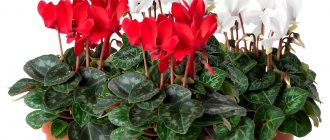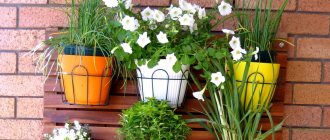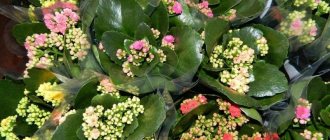People have known since ancient times that many plants can heal. It is worth choosing home flowers not only for their beauty, but also for their usefulness.
City apartments need plants that clean the air of dust, microbes and toxic substances, enrich it with oxygen, and saturate it with beneficial aromas and phytoncides.
And you should know that there are plants that will be more useful in the kitchen, where, as a rule, there is high humidity, stuffiness and fumes. And there are indoor flowers that are very useful to grow in the bedroom, which improve the microclimate in the house and have a beneficial effect on a person’s physical and mental health. Feeling their inextricable connection with nature, people have always sought to bring a piece of it into their homes. Today, scientists have proven that many indoor flowers that decorate apartments, offices, and kindergartens have a beneficial effect on a person and on the energy of the space in which he is located: they neutralize radiation, saturate the air with oxygen, absorb harmful substances, and protect against colds and depression. But what are these special indoor flowers that are useful to keep in the house?
Azalea
Azalea pleases its owners with delicate buds that bloom even in winter. Its mesmerizing flowers come in a variety of colors - from snowy white to lilac and dark red. Against the background of windows painted with frost, they look simply amazing and create a special aura in the house. The plant sometimes blooms so profusely that even the leaves are not visible behind its flowers.
Azalea smoothes out conflicts, reduces the level of aggression, even in animals, removes nervousness, and relieves fatigue. To get into a positive mood, sit next to this flower. You will feel how it relieves tension, takes away worries and worries, makes your thoughts cleaner and calmer.
Azalea relieves eye fatigue, eliminates inflammation caused by both insomnia and long hours of work at the computer, and even, according to experts, improves vision. And the petals of the plant are used to treat stye: they are secured with a bandage on the inside of the wrists for 5-6 hours.
For people of creative professions, azalea gives inspiration, a sense of self-confidence, faith in one’s own strength, and helps to cope with anxiety in important situations. Plants with dark red flowers repel moths, house ants, tree beetles and other small pests.
Sweet pepper
How to grow peppers on a windowsill? Doing this is no more difficult than growing tomatoes. True, you will have to wait longer for the harvest - 5-6 months. But pepper is a perennial plant; with good care, annual replanting and pruning, it will bear fruit for several years.
The plant can be propagated not only by seeds, but also by cuttings. Caring for peppers is also similar to caring for tomatoes, but with one significant difference - while the tomato does not tolerate stagnant air, the pepper is afraid of drafts, so it is better not to place them on the same window.
Self-pollinating early-ripening varieties are best suited for growing in an apartment - Californian Miracle, Oda, Jupiter, Patio-Ivo.
Pepper needs good light, warmth, and loose soil (it is necessary to loosen the soil regularly). This plant is not capricious, and will delight you with its fruits for a long time. You can also grow hot peppers at home, but these plants should not be in the same room, otherwise cross-pollination will occur.
Sometimes you want to go out onto the balcony, like Jamie Oliver, pick up your own grown vegetables and herbs and make something stunning out of them. And the balcony, by the way, looks much nicer if it contains not old pieces of iron that should be sent to a landfill, but aromatic herbs and vegetables.
Bright Side has selected several interesting plants that take root well on a windowsill or balcony.
Pepper
You can grow hot pizza peppers Diablo on your windowsill. It will require a warm, bright place and varieties suitable for home cultivation: “Carmen”, “Flint”, “Ogonyok”, “Ryabinushka”, “Bride”, “Indian Summer”, etc.
The bushes are very cute and do not require large pots. One plant can bear up to 50 fruits. The optimal temperature is 25-27 degrees Celsius.
Carrot
To grow carrots at home, it is better to take mini-varieties such as Parmex, Sofi, and Vnuchka. They grow in 80-90 days and do not require much space - they are quite happy with a pot or container. You can also take the funny round variety “Round Baby”.
The soil for carrots should be light and well-drained. The vegetable can be grown in cut plastic bottles. The optimal temperature is within 13-24 degrees Celsius.
Mint
Mint is a non-capricious and undemanding plant. It can grow on your windowsill or balcony even in winter, if you provide additional lighting. It can be grown from cuttings and seeds. If you have the opportunity to dig up cuttings at your own or friends’ dacha, it is better to use this method. Mint grown from seeds is not as widely accepted, and you will have to wait longer for the harvest.
It is important to remember that the plant loves well-moistened soil. And, when you choose a place for it, keep in mind that the lighting should be good, but it is better to avoid direct sunlight. The optimal temperature for mint is 20-25 degrees plus.
Green onions
To grow green onions at home, no special dexterity is required. But it’s still worth taking into account some nuances: the bulb that you will plant should be round, dense to the touch and without signs of rot, the root cup should be well formed.
Immediately after planting, you should put the onion in a cool, dark place so that the root system can better form, and only then will the onion need a lot of light. The optimal temperature is 18-20 degrees; you should not overheat, because then the growth of greenery will stop.
Basil
Any variety of basil grows well in flower pots and boxes. It is better to give it a sunny place, water it well, keep it warm and provide good drainage. For planting, you can use both cuttings and seeds. In this case, the cuttings will quickly produce the first harvest, but will not last long, as they will bloom quickly. You will have to wait longer for the harvest from the seeds, but such a bush will also last longer.
The optimal temperature for basil is 20-25 degrees Celsius. In winter, backlighting is required for approximately 3-4 hours to increase daylight hours.
cucumbers
To grow cucumbers on a windowsill or balcony, you should take a closer look at the hybrid varieties that are marked with the F1 icon. If all conditions are created for the plant, it can produce 3-4 dozen fruits. Here you will have to tinker a little with the seedlings, but after transplanting into boxes you will only need to water and trim the tendrils.
Plant plants in containers with a volume of at least 5 liters. It is important to remember that cucumbers are big water feeders and the soil should always be moist. The optimal temperature is 21-24 degrees Celsius.
Tomatoes
Dwarf varieties are usually chosen as home tomatoes: “Minibel”, “Florida Petit”, “Balcony Miracle”, etc. You will have to allocate the most illuminated place in the apartment to this miracle. You will need to start with seedlings, then plant them in containers, tie them up, feed them and protect them from the cold. This is one of the most troublesome balcony crops, but the harvest comes with pride in the work done and gardening talent.
It is important to remember that tomatoes, like all plants, love water, but they are easy to water. Therefore, watering should be done carefully. The optimal temperature is 23-25 degrees Celsius.
Sorrel
In addition to its wonderful taste, sorrel is distinguished by the fact that it tolerates shaded areas. It can be grown from the rhizomes of 2-4 year old plants with buds or from the seeds of such varieties as “Maikopsky”, “Altaisky”, “Odessky broadleaf”.
It can grow at 5 and 20 degrees Celsius and can even withstand slight frosts. So you can keep it on the balcony until the last minute, and if the balcony holds the heat well, then you don’t have to put it away for the winter. Leaves are cut at a height of 8-10 cm; this must be done carefully so as not to damage the growth buds.
Ginger
Ginger is not only a delicious seasoning, but also a beautiful plant. If planted at home, the sprouts can grow up to a meter in height. Plant pieces of ginger root, consisting of at least a couple of sections with live buds. If the root has dried out, you can keep it in warm water for several hours so that the buds wake up.
The root should not be planted very deeply, and until the first shoots appear, it should be watered very sparingly. Ginger should be kept in the light, but away from direct sunlight. The optimal temperature is 20-25 degrees Celsius.
A pineapple
To grow a pineapple at home, you need to be patient and find a suitable fruit - purchased in the warm season and with an intact tail. The tail is cut off with a knife, preferably without pulp, dried for 3-4 days in the light, and then germinated in clean river sand. When the roots appear, after about a month, it can be transplanted into a pot with soil.
Pineapple loves light, warmth and spraying. The fruit will appear about 2 years after planting. The optimal temperature is 23-30 degrees Celsius.
Strawberry
Strawberries can be grown at home all year round; in winter you will need to provide lighting. To do this, you should choose remontant strawberry varieties that bear fruit not just once a season, but constantly, for example: “Yellow Miracle”, “Queen Elizabeth”, “Mount Everest”. You can grow strawberries from seeds, but the easiest way is to buy ready-made seedlings. After 3-4 months, a couple of bushes will give new rosettes, and your plantation will increase by 3 times. Meanwhile, as with germination of seeds, you will have to tinker.
Strawberries are afraid of the cold, so you should take them out onto the balcony only when the weather is warm. The optimal temperature is 18-24 degrees Celsius. It is important to remember that since there are no insects at home, you will have to pollinate the flowers yourself with a brush.
Thyme
Thyme is a wonderful herb. It is very fragrant, tasty and extremely unpretentious. In nature, thyme grows in dry areas with poor soil. Therefore, it is not easy to ruin it at home. The most important thing he loves is light. It is not afraid of direct sunlight, and can be placed even where other plants would die. The only difficulty is watering: in the sun, the soil in a small pot dries out quickly, and the thyme itself does not like being waterlogged.
There is also no point in overdoing it with fertilizers - thyme will not appreciate it. It can be grown both from cuttings and from seeds.
What goodies grow in your home?
Dear friends, at the request of those of my readers who do not have summer cottages at all, but really want to eat food grown with their own hands, I am starting a series of articles “Vegetable garden on the windowsill.”
Since I myself have my favorite and dear summer cottage, I was not particularly interested in the issues of growing something there at home. As it turned out, it was absolutely in vain! Undoubtedly, this requires specific knowledge of certain nuances, but how much benefit and joy can be obtained from this process.
Chlorophytum
Chlorophytum is an unpretentious, fast-growing plant that copes with indoor air purification better than any air conditioner. Chlorophytum is a flower necessary for your home - a wonderful air purifier from dust and chemical gases, it refreshes the air in 24 hours more effectively than special devices, freeing it from all harmful impurities.
Just remember to wash off the accumulated dirt at least once a week. One plant such as chlorophytum is enough to reduce the effects of nitrogen oxides in a kitchen where gas is burning. This has been proven by experiments carried out in the USA by NASA employees. It is no coincidence that astronauts take this flower with them on their journey. Chlorophytum is merciless to harmful bacteria, moldy fungi, and toxic secretions, therefore it is deservedly considered one of the best natural orderlies. So that you can always breathe clean air, this flower must be in the kitchen, because it can cope with 80% of harmful impurities entering the air within a day.
Chlorophytum is a child of the subtropics; in nature it grows on trees, grass, and on the ground. In apartments, it is most often used as an hanging plant, that is, they decorate flower stands, shelves and walls with it. As a decorative element, the flower is very impressive: it quickly grows into lush bushes, and in the spring it produces numerous shoots with tiny flowers that look like white stars.
We select a plant according to the zodiac sign
What flowers should be in the house of each zodiac sign:
- For Aries, flowers that can cope with their violent temperament are suitable. These could be roses, azaleas or begonias;
- Taurus will be pleased with an unusual plant: a varietal Saintpaulia or a lily of rare colors. For representatives of the sign, not only the flower itself is important, but also the pot in which the plant is placed. Taurus will not tolerate cheap and ugly packaging for their green “pets”;
- Geminis are changeable people. A good option for a suitable flower for them would be one that does not require daily care. These are palm trees, lilies and orchids;
- When choosing indoor plants, Cancers should stick to traditional options. Ficus or Kalanchoe are ideal here;
- It is best to give Leo the brightest indoor flowers. Representatives of the sign will like the Chinese rose or camellia with its thick greenery and rich color;
- Virgos are distinguished by their practicality, so when choosing a plant, they evaluate possible options from the point of view of benefits. It is important for them that the flower brings a harvest or purifies the air in the apartment. In this case, lemon tree or chlorophytum are suitable;
- For Libras, a sense of style often comes first: they should choose elegant and sophisticated plants as gifts. Opt for an orchid or hibiscus;
- Scorpio has quite heavy energy: not every plant is able to get along with him. The best option here would be azalea;
- active Sagittarius will not be able to get along with calm plants, but they will definitely like exotic flowers. Representatives of the sign should take a closer look at indoor lemon;
- Capricorns will prefer flowers that do not require special care. Ficus will be the best gift for them;
- Aquarians always give preference to everything unusual; They, for example, will consider arrowroot a flower with a “twist”;
- Pisces love those plants that bloom beautifully. A pleasant aroma is also an important condition when choosing. Representatives of the sign should be given an orchid or azalea.
Spathiphyllum - “female happiness”
Spathiphyllum is popularly called the flower “female happiness.” It is believed that it brings good luck to the beautiful half of humanity in their personal lives: it helps unmarried girls find their love, and helps married girls to establish harmony in the family. If you believe popular beliefs, only spouses who love and respect each other will be delighted by spathiphyllum with its unusual, sail-like flowers.
It has “feminine happiness” and other beneficial properties: it releases substances that help a person relieve stress, well moisturizes and ozonates dry air, and cleanses it of harmful toxins. Spathiphyllum does not disdain even the most menial work. It can cope not only with colonies of microorganisms, but also with vapors of ammonia, benzene, acetone and various alcohols. Spathiphyllum absorbs carbon monoxide, xylene, toluene, formaldehyde, and has no equal in the fight against chemicals and moldy fungi. You can put a flower in any room. Along with the “white sails,” it’s good to move into a new apartment that has recently been renovated: thanks to spathiphyllums, you will breathe clean air.
Basil
What can you grow on a windowsill besides regular onions, parsley, and lettuce? Something more exotic like basil or rosemary.
The type of basil does not matter; green or purple will do. Basil can be propagated either from seeds or from cuttings. The plant is thermophilic - the optimal temperature is 20-25 degrees, and moisture-loving - good drainage and abundant watering are required.
Cuttings are a quick way to grow basil. You can simply buy a few branches in the store, put them in water and after one or two weeks move the seedling with roots into a pot. The young shoots will be ready for cutting in a couple of weeks. It is better to cut off the side shoots.
Basil planted from cuttings grows quickly, but also blooms quickly. As you know, after the start of flowering the plant is unsuitable for food. To have fresh basil on your table all the time, you need to replant the plantings every 3-4 months.
Planting basil from seeds will require more effort. But such a bush will not bloom for about a year. The seeds need to be soaked, covered, and the sprouts transplanted into pots. It is better to grow basil using seeds in the spring, since additional lighting will be needed in winter.
Geranium (pelargonium)
Geranium (pelargonium) is an unpretentious and surprisingly useful flower. Our grandmothers used compresses from its mashed leaves to treat runny noses, otitis media, headaches, muscle pain, and ulcers on the body. Pelargonium has long been held in high esteem: ladies of the court decorated their hats with flowers, and healing balms were made from the juice of the plant. Both in Rus' and in medieval Europe, geranium was used to fight evil spirits and protect against black magic.
This beautiful plant, which blooms with pink, red and white flowers, exudes the scent of mint, rose, almond, lemon, apples and lilac, is very much appreciated today. Geranium will not only decorate your home, but will also refresh stale air, rid it of dampness and pathogenic microbes, and in summer it will repel flies. The plant is well suited for both the kitchen and the bedroom. The main thing is not to place it next to the bed.
The aroma emitted by pelargonium inflorescences has a beneficial effect on metabolic processes, lowers blood pressure, relieves nervous tension, and helps with insomnia. If you are very tired, sit next to the geranium, but not for long, otherwise you may get a headache. The plant has too powerful energy. Pelargonium strengthens character, develops a sense of humor, and promotes personal success.
Tomatoes
Many people think that growing tomatoes on a windowsill is a very difficult task and inaccessible to a beginner. But this is not true at all! Moreover, there are special varieties for indoor cultivation.
When visiting a gardening store, note that some seed packages say “Recommended for pot growing”, “Window harvest”, “Home garden”. And the names of the varieties themselves are telling - Room Surprise, Balcony Miracle, Japanese Room. There are also hanging varieties that will look great in flowerpots - Peruvian Homemade, Cherry, Talisman.
Even if you don’t find special indoor varieties, regular ones will do. Please note that these tomatoes must be determinate (short, or better yet dwarf), self-pollinating (for pollination, the bushes are shaken during flowering) and small-fruited. For example, Alaska, Bonsai, Bonsai micro, Pearl (red and yellow), Canada News, Minibel, Pinocchio, etc.
Tomatoes can be planted immediately in large pots or picked, choosing the strongest sprouts. During the period of flowering and fruit set, tomatoes need to be watered generously and the leaves should be sprayed.
The room where tomatoes grow needs to be regularly ventilated - plants do not like stagnant air. In winter they need additional lighting. The plant must be fed periodically. The first fruits can be obtained in 3-4 months.
Tomato is a perennial plant. At home, with good care, it will bear fruit for several years. After a period of active fruiting, the bush needs to be transplanted into a larger pot and updated by pruning the branches. In addition, tomato can be propagated by cuttings. A plant grown from a cutting will begin to bloom within a few weeks.
Aloe arborescens (agagave)
Aloe - special substances that this flower releases into the atmosphere, absorb harmful emissions from linoleum, remove electricity in the room and have a positive effect on the human biofield. At night, the plant produces oxygen, so the place for a pot of aloe is in the bedroom.
Since ancient times, people believed that this flower brings good luck and protects against unkind people and evil forces. Aloe does not like guests, so it is better to hide the plant from prying eyes.
It is impossible not to mention the multifaceted medicinal properties of this useful flower. Aloe is an “ambulance” at home. Its juice is used to treat runny nose, headaches, digestive tract problems, skin diseases, and washed and cut in half leaves are applied to wounds and burns. Aloe perfectly disinfects and accelerates the healing of damaged tissue. It’s also worth learning from this resident of hot deserts about perseverance and love of life.
Need to decorate the bathroom
Option: Brighamia or Hawaiian palm (Brighamia insignis)
Ideal temperature: 20 to 22 ° C. Light: intense. Bloom: autumn/winter. Dimensions: 50 cm.
She loves warm and humid atmospheres. If she is satisfied with the care, then every autumn she gives flowers with a light honey aroma. Palm is ideal for a bathroom with a window facing southwest or west. She won't be able to live in the dark. In summer it is better to take it out onto the balcony and enjoy the sun. The soil should be allowed to dry between waterings and fertilized every 15 days. Brigamia is replanted every 2 years.
Alternatives: fern (nephrolepis), dieffenbachia, dallalia.
Cactus
Cactus - this exotic plant was eaten in ancient times, medicines were made from it, and the needles were used as toothpicks.
The cactus is a protective plant. It is good to place it on windowsills. Place one cactus on a north window, another on a west window, and so on. This arrangement will help protect your home from thieves. You should not place cacti in the bedroom where spouses sleep, this reduces sexual fervor.
Experts advise placing cacti in the office. They absorb positive cations from the air, an excess of which leads to headaches.
The cactus, in addition to being unpretentious, can please its owners with a wide variety of shapes and delicate, beautiful flowers. If you properly care for a cactus, it will make the energy in the house more harmonious and balanced, clear the space of negative energy, and help improve the financial situation of its inhabitants. According to Feng Shui, this flower symbolizes accumulation, as it can use moisture very economically. The main thing is to water the plant in a timely manner so that it does not turn from a prickly helper into an energy vampire.
You should not place a cactus in the bedroom where spouses sleep: it can provoke “prickly” relationships, quarrels and disagreements, and also reduce sexual fervor. But in the office his presence is very appropriate.
Parsley
Many housewives are wondering how to grow parsley on a windowsill. After all, you often only need a few leaves of this plant, and you don’t want to buy a whole package in the store. In spring and summer, parsley can be grown from seeds.
The plant is light-loving, so in winter it will need additional lighting. The seeds germinate rather slowly, but the bush will last a long time. Parsley is not picky about temperature; it grows well on a windowsill or balcony. The plant is moisture-loving and is watered abundantly. In winter, parsley needs to be watered less often.
It will be possible to cut the first greenery only after a month and a half, but it will be possible to do this for a whole year. Before planting, it is better to soak the seeds in a solution of potassium permanganate. You can plant parsley in small containers, in peat cups or directly in flowerpots.
How to grow parsley on a windowsill in autumn and winter, because growing from seeds at this time is too long and labor-intensive? There is another way - forcing it from the rhizome. This method is somewhat simpler and better suited for the autumn-winter period. Planting material can be prepared independently in a personal plot or purchased at a regular grocery store.
The rhizome must be healthy, without signs of wilting, and the apical bud must be intact. The root crop should be placed in a pot and sprinkled with damp soil. Roots that are too long can be planted at an angle.
The first green shoots will appear within a few days after planting, and the leaves can be cut off in a couple of weeks. Greens will appear on the rhizome within six months.
Indoor violet (Saintpaulia)
Indoor violet - many people associate it with the arrival of spring, and the leaves of the plant, shaped like a heart, are considered a talisman for lovers. Extremely unpretentious, but blooming almost all year round, Saintpaulias have a positive effect on the atmosphere in the house: they awaken in a person a desire to act, develop sociability and love of life, and bring joy and harmony to the house. They have a soft, calming energy, help to tune into a positive mood, get rid of tension and insomnia. In a house where violets bloom, love and harmony reign. The influence of violets on humans is multifaceted, it all depends on the color of their flowers.
White Saintpaulias will be appropriate in any room. They calm, relieve anxiety and worries, help cope with excessive irritability and fatigue, clear the space from the negative influence of bad thoughts, and help keep the house clean.
Pink and red Saintpaulias are best placed in the kitchen. They harmonize the energy in the home, protect against illness, improve mood, give a feeling of calm, help a person feel the joy of communication and work, and get rid of bad habits, in particular, overeating.
Violets with blue flowers are especially useful for creative people. They relieve despondency and apathy, help cope with depression, give inspiration, fill space with creative energy, and help a person reveal his creative potential.
Saintpaulias with purple flowers clear the space of the energy of mistrust, help achieve mutual understanding between the residents of the house, promote spiritual growth, elevating thoughts, strengthening character, and developing intuition. True, they have no place in children's rooms and offices.
I want something unusual
Variant: Medinilla (Medinilla magnifica)
Ideal temperature: 22 to 25 ° C. Light: intense. Bloom: spring. Dimensions: from 1 to 1.50 m.
Everything about it is surprising - clusters of pink flowers, large leaves (20 to 25 cm long), quadrangular stems... She will like it in well-lit places on the south side of the house. Do not allow the soil in the pot to dry out. The leaves of the flower need to be sprayed regularly. Fertilizers are applied every 15 days, and replanted every two to three years in soil enriched with a handful of compost.
Alternatives: syngonanthus, Rowley's ragus, jatropha.
Ficus
Ficus - this beautiful flower with fleshy, glossy leaves has always been one of the most desirable inhabitants in the house. In addition to saturating the air with oxygen, it also cleanses it, but not only from toxins. Like a vacuum cleaner, ficus absorbs the dust of our worries and doubts. The plant also releases substances that have a positive effect on sleep. Its presence in the bedroom will help you fall asleep peacefully and wake up cheerfully. In addition, the flower improves mutual understanding between loving hearts, helps spouses achieve harmony in relationships, become more patient and attentive to each other.
Ficus has a very positive effect on the character of the people living in the house. It calms, relieves anxiety and aggression, instills optimism, eradicates the need to arouse pity from others, develops enthusiasm, teaches you how to rationally distribute your time, and helps you concentrate. His presence is very welcome in rooms where work is in full swing. Ficus also helps to overcome the fear of public speaking. They even advise you to rehearse your speech before the flower.
It is believed that all types of ficus have a beneficial effect on the atmosphere of the home. They filter indoor air well, absorbing harmful substances such as benzene, phenol and trichlorethylene. The plant binds them and processes them into amino acids and sugars. Ayurvedic practice emphasizes the benefits of ficus as a plant that harmonizes home energy. It is believed that ficus clears the surrounding space of anger, anxiety and worries, which contributes to a positive solution to difficult life situations. There is a sign that if there are no children in a family for a long time, it is necessary to plant a ficus.
It is read that all types of ficus have a beneficial effect on the atmosphere of the house. They filter indoor air well, absorbing harmful substances such as benzene, phenol and trichlorethylene. The plant binds them and processes them into amino acids and sugars. Ayurvedic practice emphasizes the benefits of ficus as a plant that harmonizes home energy. It is believed that ficus clears the surrounding space of anger, anxiety and worries, which contributes to a positive solution to difficult life situations. There is a sign that if there are no children in a family for a long time, it is necessary to plant a ficus. However, this in no way cancels visiting a doctor.
Leaf salad
Growing leaf lettuce is already somewhat more difficult. To know how to grow lettuce on a windowsill, you need to take into account the variety of the plant being grown. The varieties Lollo Rossa, Lollo Bionda, Odessky, Vitaminny, New Year, and Red Credo perform best in apartment conditions.
In autumn and winter, leaf lettuce will need additional lighting. If the room is hot and dry, the plant does not receive enough moisture, then the leaves will become bitter, become coarse, and flower stalks will quickly form. Leaf lettuce loves moisture and coolness and feels good on a glassed-in balcony until late autumn.
Leaf lettuce is planted in the ground quite densely, at a distance of 1-2 cm. Before the first shoots, the container is covered to create a greenhouse effect. Over time, thinning to a distance of 4-5 cm will be necessary. The plant needs watering and good lighting.
After the bushes begin to produce arrows, they become unsuitable for consumption. They can be removed and new seeds planted in their place.
Common myrtle
Myrtle (myrtle tree) is not only a very beautiful plant, but also an extremely useful plant for humans. It is considered a symbol of family happiness and the guardian of the hearth. In Ancient Greece, brave warriors were honored with graceful branches of myrtle, wreaths were woven from them for brides, and cooks used the dried leaves of the plant for cooking.
During flowering, myrtle is covered with small, star-like flowers. But it pleases its owners not only with its attractive appearance, but also with its multifaceted healing properties. The plant destroys about 40% of pathogenic microorganisms present in the air, thereby reducing the risk of colds. The smell of myrtle cleanses the mind, has an enlightening effect, helps a person restore harmony with the outside world, and brings peace and happiness to the home.
Myrtle oil is very popular among perfumers. And herbalists consider myrtle to be a universal plant. It is used to treat allergies, blood and eye diseases, intestinal and bladder diseases, as an antitumor and anti-inflammatory agent. Myrtle grows well and can be used for decorative purposes to create bonsai. Myrtle is also suitable for decorating a winter garden, and due to its shade tolerance, it is suitable for interior landscaping.
I want flowers all year round
Option: Anthurium
Ideal temperature: 20 to 22°C. Light: intense to low. Flowering: all year round. Dimensions: from 30 to 80 cm.
Varieties with small flowers bloom most actively. The plant tolerates almost any conditions, except direct sunlight. The soil should dry out a little between waterings and be fed every three weeks. For continuous flowering, faded flowers must be removed regularly. When the anthurium grows and its roots come out of the pot, it is divided into two parts and replanted in a soil mixture for orchids.
Alternatives: Saintpaulia, spathiphyllum.
I want a non-capricious orchid
Option: Cambria
Ideal temperature: 20 to 25 ° C. Light: medium. Flowering: all year round. Dimensions (in pot): from 60 to 80 cm.
A charming and touching orchid will easily transform any space. But the disposition of most of its varieties is quite capricious. Its most famous alternative is phalaenopsis. But the Cambria variety is no less hardy and patient. She will easily survive the cool weather (about 15 ° C). The best place for it is a window sill in the east or west of the house. It is important not to let the substrate dry out. From the appearance of new shoots until the end of their flowering, you need to add special fertilizers for orchids. Every year at the end of spring or autumn, it is advisable to replant it in a mixture of 60% pine bark, 20% sphagnum and 20% clay balls.
Alternatives: phalaenopsis, zygopetal, prostochia.
If you liked the article, then here you will find more materials on this topic











